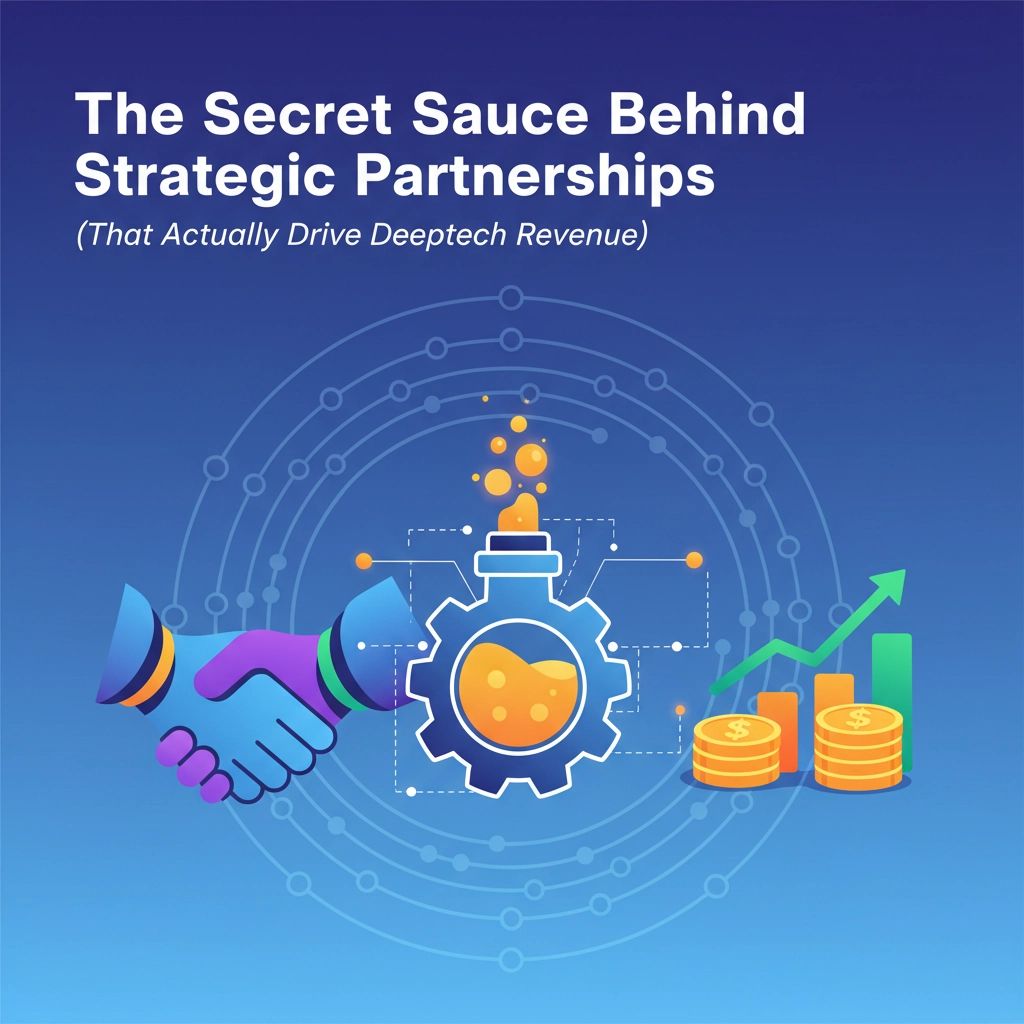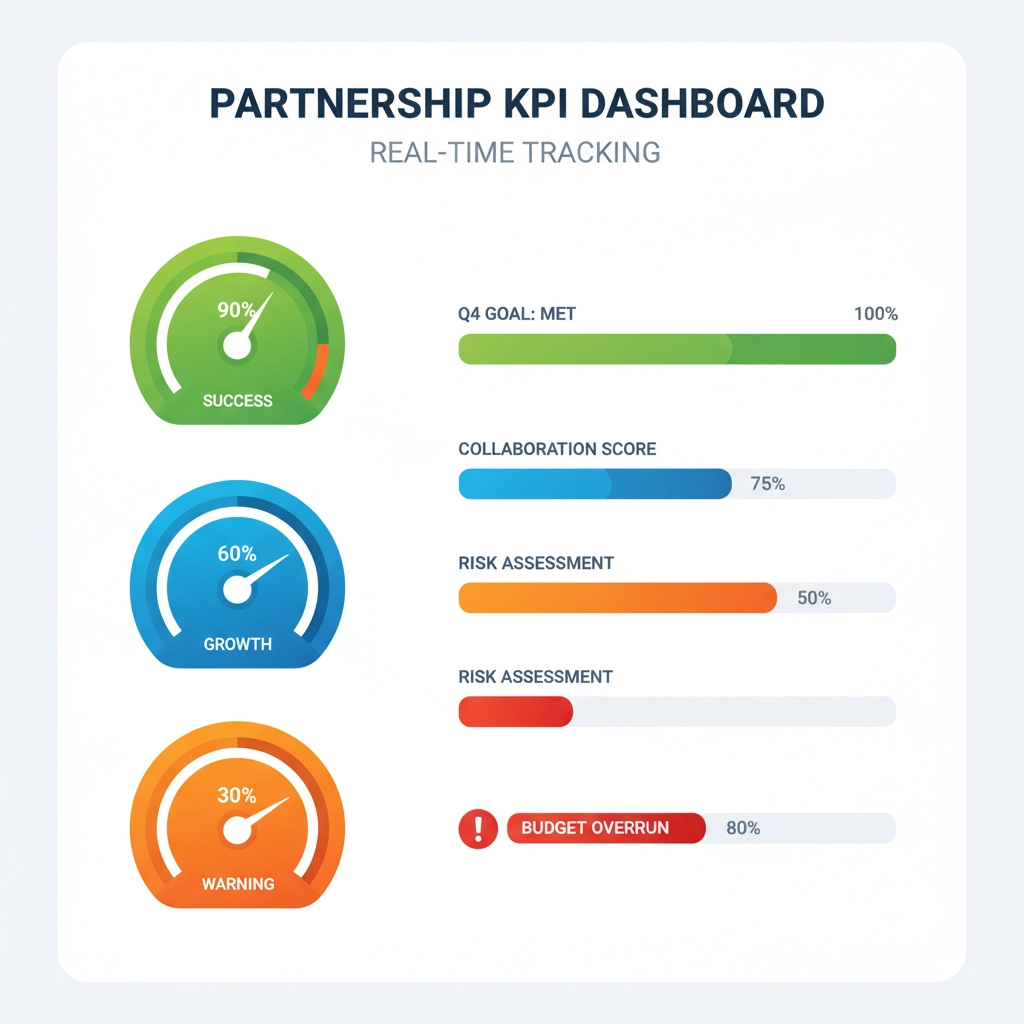The Secret Sauce Behind Strategic Partnerships (That Actually Drive Deeptech Revenue)
Nov 20, 2025
Most strategic partnerships in deeptech and healthtech are expensive science experiments disguised as business development. You've seen them: those fancy press releases announcing "groundbreaking collaborations" that quietly fade into nothing six months later.
But some partnerships actually move the revenue needle. In our latest Deeptech Insider #33, we dug into what separates the winners from the press release graveyard. Here's what we found.
The Partnership Paradox: Why Good Intentions Fail
The biggest lie in deeptech partnerships? That shared vision equals shared success.
Most founders approach partnerships like dating: lots of excitement, vague promises, and zero concrete plans for making money together. You'll spend months in "strategic alignment meetings" discussing synergies while your burn rate climbs and your runway shrinks.
The harsh reality: partnerships without clear revenue models are just networking with extra steps.

The Real Secret Sauce: Revenue-First Partnership Design
The partnerships that actually drive revenue start with one simple question: "How does this make us money in the next 12 months?"
Not "How might this theoretically create value someday." Not "What could we build together if everything goes perfectly." Just cold, hard cash flow.
Here's the framework that works:
1. Lead with Customer Problems, Not Technology
The best deeptech and healthtech partnerships solve specific customer pain points that neither company can address alone. Your AI diagnostic tool needs clinical validation? Partner with a hospital system that gets access to cutting-edge tech in exchange for real-world data and case studies.
Your quantum computing breakthrough needs industry applications? Find manufacturing partners who'll pay for exclusive pilot programs while you refine the technology for their specific use cases.
The key: your partner's customers become your proof points, and your technology becomes their competitive advantage.
2. Structure for Speed, Not Perfection
Traditional partnership negotiations drag on for months while lawyers debate intellectual property rights and liability clauses. Meanwhile, your competitors are shipping products.
The fastest partnerships use what we call "revenue-first contracting": start with a small, defined project that generates cash flow within 90 days, then expand based on results. Think pilot programs, not comprehensive strategic alliances.
For healthtech startups, this might mean a 6-month clinical validation study with a single hospital department. For deeptech companies, it could be a proof-of-concept project solving one specific problem for a manufacturing partner.

3. Make Your Partner Look Like a Hero
This is where most founders get it wrong. They focus on what the partnership can do for them, not what it can do for their partner's career, reputation, or business metrics.
The partnerships that stick are the ones where your contact becomes the internal champion who gets promoted because of your success together. Your healthtech solution doesn't just improve patient outcomes: it makes the Chief Medical Officer look innovative. Your deeptech breakthrough doesn't just solve technical problems: it makes the Head of R&D look brilliant.
Ask yourself: what does success look like for the actual person you're working with? Then design the partnership to deliver that.
The Deeptech-Healthtech Playbook: Industry-Specific Tactics
Different sectors require different approaches to partnership revenue generation.
Deeptech: The Platform Strategy
Most deeptech partnerships fail because they try to be everything to everyone. The ones that succeed pick a narrow vertical and become the go-to platform for that industry.
Take quantum sensing startups: instead of pursuing partnerships across aerospace, defense, and medical devices simultaneously, the winners pick one sector and become indispensable to key players in that space. They build partnerships that create network effects, where each new partner makes the platform more valuable to existing partners.
The revenue model: recurring platform fees, usage-based pricing, and premium support contracts. Your partners pay for access to the ecosystem you've built, not just your technology.
Healthtech: The Evidence Engine
Healthtech partnerships live or die on clinical evidence. But generating that evidence is expensive and time-consuming if you go it alone.
The smartest healthtech companies build partnerships that create evidence while generating revenue. They partner with health systems to run paid pilot programs, work with research institutions on grant-funded studies, and collaborate with pharma companies on drug development programs.
Each partnership generates three things: revenue, clinical data, and regulatory evidence. By the time you're ready to scale, you have both the cash flow and the proof points investors want to see.

As we discussed in our post on revenue traction vs. technical validation, investors increasingly prioritize commercial proof over technical brilliance. Strategic partnerships that generate real revenue serve as powerful validation for your fundraising story.
Measuring What Matters: Partnership KPIs That Actually Count
Most companies track partnership success with vanity metrics: number of signed MOUs, total addressable market of partners, or press mentions. These numbers make great board slides but terrible business indicators.
The metrics that matter:
- Revenue per partnership: How much cash each partnership generates within the first 12 months
- Customer acquisition cost through partnerships: How cheaply you can acquire new customers through partner channels vs. direct sales
- Time to revenue: How quickly new partnerships start generating cash flow
- Partner retention rate: What percentage of partnerships generate follow-on revenue or expand their scope
If a partnership can't move these numbers, it's not strategic: it's just expensive networking.
The Partnership Graveyard: Common Mistakes to Avoid
Even with the right framework, most partnerships still fail. Here are the mistakes that kill revenue potential:
Mistake #1: Partnership Theater
You spend months negotiating a comprehensive strategic alliance that looks impressive on paper but has no clear path to revenue. The partnership becomes a full-time job for your business development team, but it never generates a dollar of cash flow.
Fix: Start with a single, specific project that generates revenue within 90 days.
Mistake #2: The Integration Trap
You build complex technical integrations that take months to complete and require ongoing maintenance. Your engineering team spends more time supporting partnerships than building core product features.
Fix: Design partnerships that work with your existing product, not against it.
Mistake #3: Champion Dependency
Your entire partnership depends on one person at the partner company. When they leave, get promoted, or shift priorities, your "strategic alliance" disappears overnight.
Fix: Build relationships across multiple levels and departments from day one.

The Cash Flow Connection: Partnerships That Fund Growth
The best partnerships don't just generate revenue: they fund your growth. Instead of diluting equity or taking on debt, you use partnership revenue to extend your runway and hit key milestones.
This is especially crucial for deeptech and healthtech companies with long development cycles. As we covered in our founder-led fundraising guide, alternative funding sources become critical when you're building technology that takes years to commercialize.
Strategic partnerships that generate consistent cash flow give you the flexibility to be selective with investors and negotiate from a position of strength.
From MOUs to Money: Making It Happen
Here's the uncomfortable truth: most founders are better at building technology than building partnerships. The skills that make you a great engineer or researcher don't automatically translate to effective business development.
But you don't need to become a partnerships expert overnight. You just need to approach partnerships like you approach product development: with clear requirements, measurable outcomes, and iterative improvement.
Start small, measure results, and scale what works. The partnerships that drive real revenue aren't the ones that look most impressive on paper: they're the ones that put cash in your bank account while you build the future.

The secret sauce isn't actually secret. It's just that most founders are too busy chasing the perfect partnership to execute the profitable one sitting right in front of them.
Stop building partnerships for the press release. Start building them for the P&L.